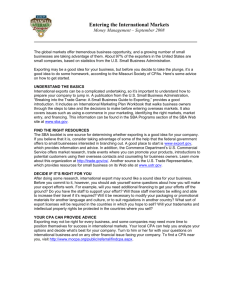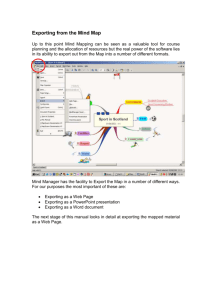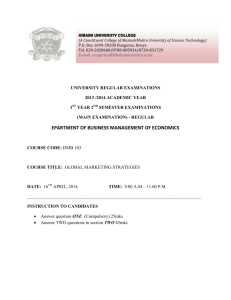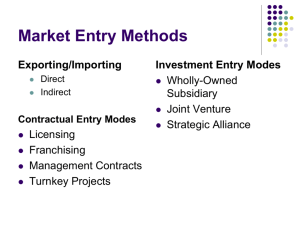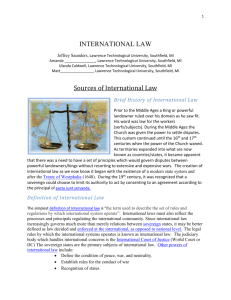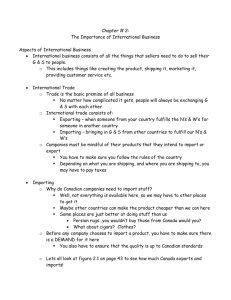WHAT IS GLOBAL MARKETING?
advertisement
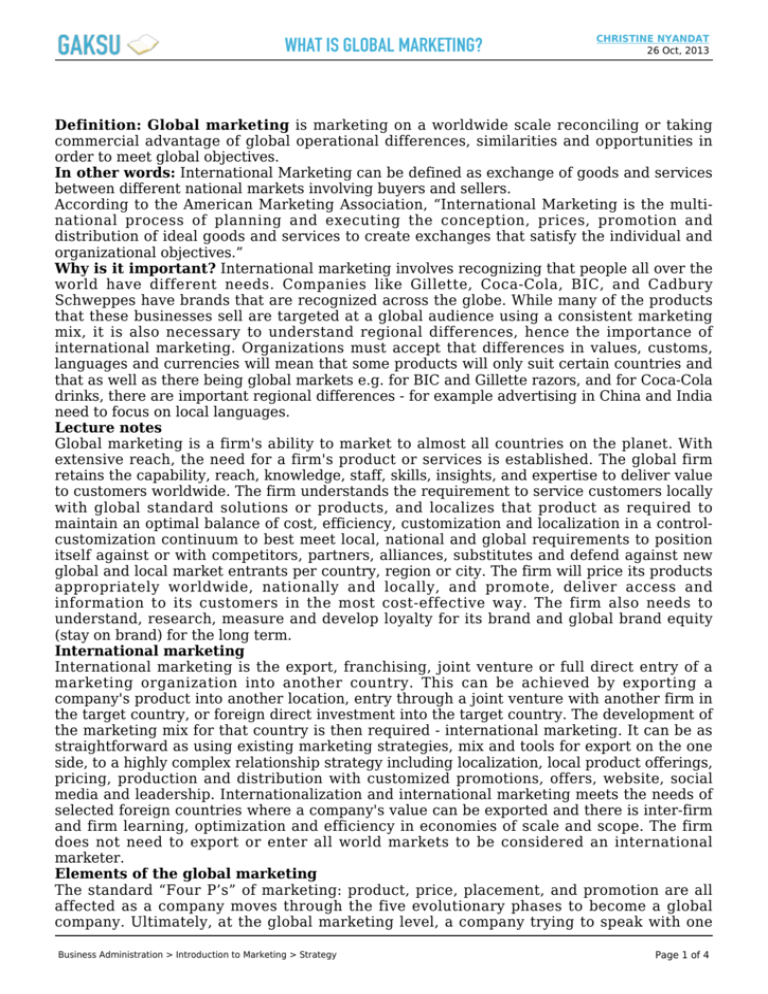
WHAT IS GLOBAL MARKETING? CHRISTINE NYANDAT 26 Oct, 2013 Definition: Global marketing is marketing on a worldwide scale reconciling or taking commercial advantage of global operational differences, similarities and opportunities in order to meet global objectives. In other words: International Marketing can be defined as exchange of goods and services between different national markets involving buyers and sellers. According to the American Marketing Association, “International Marketing is the multinational process of planning and executing the conception, prices, promotion and distribution of ideal goods and services to create exchanges that satisfy the individual and organizational objectives.” Why is it important? International marketing involves recognizing that people all over the world have different needs. Companies like Gillette, Coca-Cola, BIC, and Cadbury Schweppes have brands that are recognized across the globe. While many of the products that these businesses sell are targeted at a global audience using a consistent marketing mix, it is also necessary to understand regional differences, hence the importance of international marketing. Organizations must accept that differences in values, customs, languages and currencies will mean that some products will only suit certain countries and that as well as there being global markets e.g. for BIC and Gillette razors, and for Coca-Cola drinks, there are important regional differences - for example advertising in China and India need to focus on local languages. Lecture notes Global marketing is a firm's ability to market to almost all countries on the planet. With extensive reach, the need for a firm's product or services is established. The global firm retains the capability, reach, knowledge, staff, skills, insights, and expertise to deliver value to customers worldwide. The firm understands the requirement to service customers locally with global standard solutions or products, and localizes that product as required to maintain an optimal balance of cost, efficiency, customization and localization in a controlcustomization continuum to best meet local, national and global requirements to position itself against or with competitors, partners, alliances, substitutes and defend against new global and local market entrants per country, region or city. The firm will price its products appropriately worldwide, nationally and locally, and promote, deliver access and information to its customers in the most cost-effective way. The firm also needs to understand, research, measure and develop loyalty for its brand and global brand equity (stay on brand) for the long term. International marketing International marketing is the export, franchising, joint venture or full direct entry of a marketing organization into another country. This can be achieved by exporting a company's product into another location, entry through a joint venture with another firm in the target country, or foreign direct investment into the target country. The development of the marketing mix for that country is then required - international marketing. It can be as straightforward as using existing marketing strategies, mix and tools for export on the one side, to a highly complex relationship strategy including localization, local product offerings, pricing, production and distribution with customized promotions, offers, website, social media and leadership. Internationalization and international marketing meets the needs of selected foreign countries where a company's value can be exported and there is inter-firm and firm learning, optimization and efficiency in economies of scale and scope. The firm does not need to export or enter all world markets to be considered an international marketer. Elements of the global marketing The standard “Four P’s” of marketing: product, price, placement, and promotion are all affected as a company moves through the five evolutionary phases to become a global company. Ultimately, at the global marketing level, a company trying to speak with one Business Administration > Introduction to Marketing > Strategy Page 1 of 4 WHAT IS GLOBAL MARKETING? CHRISTINE NYANDAT 26 Oct, 2013 voice is faced with many challenges when creating a worldwide marketing plan. Unless a company holds the same position against its competition in all markets (market leader, low cost, etc.) it is impossible to launch identical marketing plans worldwide. Product A global company is one that can create a single product and only have to tweak elements for different markets. For example, coca-colauses two formulas (one with sugar, one with corn syrup) for all markets. The product packaging in every country incorporates the contour bottle design and the dynamic ribbon in some way, shape, or form. However, the bottle can also include the country’s native language and is the same size as other beverage bottles or cans in that same country. Price Price will always vary from market to market. Price is affected by many variables: cost of product development (produced locally or imported), cost of ingredients, cost of delivery (transportation, tariffs, etc.), and much more. Additionally, the product’s position in relation to the competition influences the ultimate profit margin. Whether this product is considered the high-end, expensive choice, the economical, low-cost choice, or something in-between helps determine the price point. Place How the product is distributed is also a country-by-country decision influenced by how the competition is being offered to the target market. Using Coca-Cola as an example again, not all cultures use vending machines. In the United States, beverages are sold by the pallet via warehouse stores. In India, this is not an option. Placement decisions must also consider the product’s position in the market place. For example, a high-end product would not want to be distributed via a “dollar store” in the United States. Conversely, a product promoted as the low-cost option in France would find limited success in a pricey boutique. Promotion After product research, development and creation, promotion (specifically advertising) is generally the largest line item in a global company’s marketing budget. At this stage of a company’s development, integrated marketing is the goal. The global corporation seeks to reduce costs, minimize redundancies in personnel and work, maximize speed of implementation, and to speak with one voice. If the goal of a global company is to send the same message worldwide, then delivering that message in a relevant, engaging, and costeffective way is the challenge. Deciding Whether to Go Global Factors to consider • Global competition in the home market • Stagnant or shrinking home market • Foreign markets with more opportunity • Expansion of customers to international markets Define international marketing objectives and policies • Foreign sales volume • How many countries to market to • Types of countries to market to based on: • Geography • Income and population • Political climate Rank potential global markets based on: • Market size • Market growth • Cost of doing business • Competitive advantage Business Administration > Introduction to Marketing > Strategy Page 2 of 4 WHAT IS GLOBAL MARKETING? • CHRISTINE NYANDAT 26 Oct, 2013 Risk level Ways to enter global markets include: Exporting is when the company produces its goods in the home country and sells them in a foreign market. It is the simplest means involving the least change in the company’s product lines, organizational, investments, or mission. • Indirect exporting • Direct exporting Exporting Indirect exporting is when the firm works through an independent international marketing intermediary. This requires less investment and risk since the firm does not require an overseas organization or network. Direct exporting is when the firm handles its own exports. This requires a greater investment and risk. • Domestic export department • Send home-based sales people abroad • Use of foreign distributors Joint venturing is when a firm joins with foreign companies to produce or market products or services • Licensing • Contract manufacturing • Management contracting • Joint ownership Joint venturing differs from exporting in that the company joins with a host country partner to sell or market abroad Licensing is when a firm enters into an agreement with a licensee in a foreign market. For a fee or royalty, the licensee buys the right to sue the company’s process, trademark, patent, trade secret, or other item of value Contract manufacturing is when a firm contracts with manufacturers in the foreign market to product its product or provides its service. Benefits include faster startup, less risk, and the opportunity to form a partnership or to buy out the local manufacturer. Management contracting is when the domestic firm supplies management skill to a foreign company that supplies capital. The domestic firm is exporting management services rather than products. Joint ownership is when one company joins forces with foreign investors to create a local business in which they share joint ownership and control. Joint ownership is sometimes required for economic or political reasons. Direct investment is the development of foreign-based assembly or manufacturing facilities and offers a number of advantages: Lower costs • Raw material • Labor • Government incentives • Logistics • Control Deciding on the Global Marketing Program Standardize marketing mix involves selling the same products and using the same marketing approaches worldwide Adapted marketing mix involves adjusting the marketing mix elements in each target Business Administration > Introduction to Marketing > Strategy Page 3 of 4 WHAT IS GLOBAL MARKETING? CHRISTINE NYANDAT 26 Oct, 2013 market, bearing more costs but hoping for a larger market share and ROI Product Strategies Straight product extension means marketing a product in a foreign market without any change Product adaptation involves changing the product to meet local conditions or wants Product invention consists of creating something new for a specific country market • Maintain or reintroduce earlier products • Create new products Promotion Strategies Companies can either adopt the same communication strategy they use at home or change it for each market Price Strategies Uniform pricing is the same price in all markets but does not consider income or wealth where the price may be too high in some markets or not high enough in other markets Market-based pricing is the price that markets can pay but does not consider actual costs Standard markup pricing is a price based on a percentage of cost but can cause problems in countries with high costs Distribution Strategies Whole-Channel View Seller’s headquarters organization supervises the channel and is also a part of the channel Channels between nations move the products to the borders of the foreign nations Channel within nations move the products from their foreign point of entry to the final customers Distribution Strategies Differences within Countries • Numbers and types of intermediaries • Size and character of retail units Typical management of international marketing activities includes: • Organize and export department with a sale manager and staff • Create an international division organized by geography, products, or operating units • Become a complete global organization Business Administration > Introduction to Marketing > Strategy Page 4 of 4

